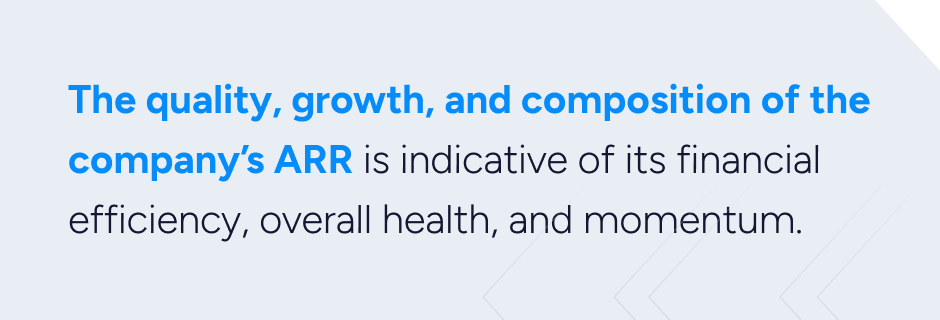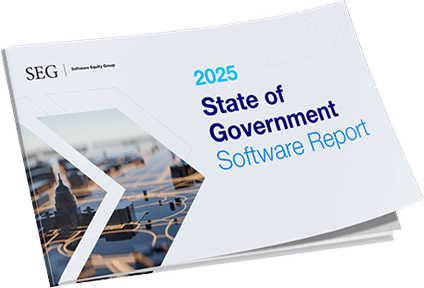Understanding ARR for SaaS Leaders: Its Impact, Calculation, and Role in Growth Strategy

Annual recurring revenue (ARR) is a critical measure of any SaaS company’s success and is one of the most important factors private equity investors and strategic buyers assess when evaluating potential acquisitions. This metric also influences financial planning and overall growth strategies for your business. But while the concept is familiar to most SaaS executives, it may not be universally understood.
Calculating and interpreting ARR and its associated metrics can be intricate. Errors in this process can result in poor strategic decisions for businesses or lead to misguided perceptions by potential buyers and investors.
In this post, we offer insights to help executives use ARR to better understand their businesses, growth trajectories, and improve positioning for a possible liquidity event.
What is ARR?
Simply put, ARR is the amount of recurring revenue a business can expect to generate each year from subscriptions. In other words, the metric normalizes contracted revenue from term-based agreements to a one-year period.

For SaaS companies, ARR is an important KPI because it is a measure of predictable revenue streams. Knowing how much revenue the company can count on from its core business (as opposed to one-off services or anomalous projects) makes it easier to make operational decisions and plan for the future. The quality, growth, and composition of the company’s ARR is indicative of its financial efficiency, overall health, and momentum. For these reasons, ARR and its trends are among the most important metrics to strategic buyers or private equity firms when making valuations.
How to Calculate ARR
To calculate ARR, you need to add up all your recurring revenue that comes from current (in-place) subscriptions. Recurring is the key word because this number should not include one-time charges (such as set-up fees).
Beyond just calculating the value of current contracts, we also need to consider the dynamic nature of the business. Some customers may have upgraded their subscriptions to pay more (which we will call Expansion Revenue), while others may have downgraded their subscriptions or canceled their contracts (called Customer Churn). With these factors in mind, we arrive at the formula for ARR:
Prior Period Annual Subscription Revenue + New Revenue + Expansion Revenue – Churned Revenue = Current ARR
As an example, say your company’s total revenue from subscriptions last year was $4.5 million. This year, you sold $1.5M of net new subscription agreements. On top of new agreements, you also sold $200,000 of upgrades (expansions). Throughout this year, customers leaving your business or downgrading their subscription amounted to a decrease of $1.5 million. The resulting calculation would look like this:
| Last Year’s Subscriptions | $4,500,000 |
| + Net New Subscription Agreements | $1,500,000 |
| + Upgrades (Expansion) | $200,000 |
| – Downgrades (Churn) | $1,500,000 |
| = ARR | $4,700,000 |
For your ARR calculation to be accurate, you need to make sure you’re calculating each component correctly.
Distinguishing ARR from Similar Terms
As you dive deeper into understanding ARR, it is essential to acquaint yourself with similar metrics and discern their nuances.
ARR vs. MRR:
An alternative way to calculate ARR is to simply multiply your MRR (monthly recurring revenue) by 12. You can annualize a singular month’s recurring revenue to give you a point-in-time view of your run-rate ARR. Similarly, you can divide your ARR by 12 to arrive at your MRR.
Revenue:
Revenue can refer to any source of income the company receives (whether recurring or not) from its operations. The term “revenue” by itself should not be used as a substitute for annual recurring revenue.
Revenue recognition:
In revenue recognition, it’s imperative to distinguish between recognizing revenue based on cash and following Generally Accepted Accounting Principles (GAAP). This distinction is crucial and should not be confused with ARR.
Reoccurring revenue:
The terms “recurring” and “reoccurring” are often used interchangeably, but this can be misleading when referring to revenue. While recurring should refer to revenue that is predictable at specified intervals (like any type of subscription), reoccurring should be used to describe purchases a customer makes repeatedly, but with no pre-designated or contracted regularity. Depending on the nature of the revenue and the predictability, this type of revenue may or may not be included in an ARR calculation.
Transactional revenue:
Unlike contractually recurring revenue, transactional revenue comes from charging customers on a usage basis rather than through subscriptions. An example of transactional revenue would be when an e-commerce payment platform receives a small fee for every purchase made through its system. Like reoccurring revenue, the nature of the revenue and predictability will ultimately determine if it is included in the ARR calculation.
One-time revenue:
When a customer purchases a product or service with no expectation of repeat purchases, it’s called one-time revenue. SaaS companies may receive some one-time revenue for set-up/training fees or support, and these would not count toward ARR.
Contracted (or committed) annual recurring revenue (CARR):
This metric provides another view of recurring revenue that also includes bookings (new customers who have yet to start paying). Compared to ARR, CARR gives a more forward-looking view, which is helpful if customers don’t typically “go live” until months after they sign a contract or if the company is growing quickly. This information will also be important for prospective buyers to consider when evaluating your company.
Bookings:
A customer is considered booked when they sign a contract, even if their go-live date has yet to occur. Bookings are not included in the ARR calculation but would be included in CARR.
Billings:
Not to be confused with bookings, billings refer to customers who have gone live and are actively paying for the use of the software. Billings for subscriptions are included in the ARR calculation.
The Impact of ARR on M&A Activity and Exit Multiples
In the context of SaaS M&A, ARR plays a significant role in assessing the value and potential of a SaaS company.
Valuation / Exit Multiples
ARR is a key component in the valuation of a SaaS company. Buyers often use ARR multiples to determine the worth of the target company. A higher ARR with positive trends implies a more valuable asset, which will affect the purchase price.
Revenue Stability
ARR provides insights into the stability of a SaaS company’s revenues. ARR with a strong retention profile indicates stable, predictable income, which is highly attractive to potential acquirers.
Customer Base
The composition of ARR, including the quantity and type of customers, contract terms, and renewal rates, sheds light on the quality of a customer base. A sticky ARR portfolio without significant customer concentration is appealing to acquirers.
Strategic Buyer Synergy Planning
Understanding the target company’s ARR helps the acquiring strategic company or private equity-backed strategic company plan for integration. It informs decisions regarding customer onboarding, retention strategies, and cross-selling opportunities, all of which are vital for post-acquisition growth.
Investor and Stakeholder Confidence
When M&A activities are aligned with growth strategies focused on increasing ARR, it can lead to increased confidence, support, and buy-in from financial backers.
The Top Metric for Your SaaS Company’s Valuation
Regardless of your exit strategy, understanding annual recurring revenue, its components, and its trends can give you powerful insights into running a successful SaaS business. It is an indicator of your company’s current health, as well as a glimpse into its future potential. Plus, it can help you verify that your business model is working and reveal shortcomings that need to be addressed, such as areas of high customer churn.
Finally, analyzing ARR can help you set realistic and measurable goals to keep your organization on the path to profitable growth.
While these are important considerations for every SaaS business, they become even more critical when you are trying to sell your company. Annual recurring revenue is a key factor that potential buyers analyze when deciding whether to acquire your business and for how much. Having a firm command of your numbers can give you more control at the negotiating table.
As you chart your course toward an eventual exit, enlist the support of a seasoned expert in SaaS mergers and acquisitions. Software Equity Group has more than 30 years of experience helping established and emerging software companies maximize the success of liquidity events. Contact us to learn more.











